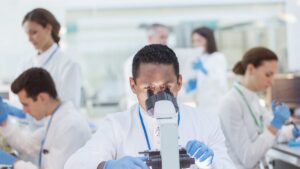Dr Boreham’s Crucible: Medical Developments is finding ways to gain without US pain

Pic: sinology / Moment via Getty Images
The home-grown Medical Developments (ASX: MVP) is well down the path of fulfilling its charter of making Penthrox the “mainstream analgesic of choice” globally.
After all, Medical Developments has been selling (or is about to sell) its temporary pain relief device – aka the Green Whistle – in 49 countries.
In Europe, the company sells the device in nine countries, notably the UK (we’ll call it Europe for the time being), Ireland, France and Belgium.
Within a year or so, Penthrox should also be available in Germany, Italy and Spain and other geographies including that current house of pain, Vatican City.
“It’s all about to happen,” says CEO John Sharman.
But there’s a glaring exception to the company’s coverage – the US.
In July last year, Medical Developments revealed the US Food and Drug Administration had put a hold on the company’s approval application “pending a letter outlining outstanding issues and concerns”.
The news sent the company’s shares down 18 per cent on the day, although about half of the lost ground has since been regained.
The Brexit process has also slowed the European approval process (see below).
Penthrox through the ages
Medical Developments is all about re-inventing Penthrox – formally known as methoxyflurane – first used here in 1975.
Declaring It’s Time for a fast-acting, non-addictive painkiller, prominent anaesthetist Dr David Komesaroff founded Medical Developments in 1972.
Penthrox was (and is) pitched as a rival product to nitrous oxide (laughing gas), morphine, Fentanyl (another opioid) and ketamine (better known as a horse tranquilliser).
Steered by current chairman and biggest shareholder David Williams, Medical Developments listed on the ASX in December 2003, after raising $8.7 million at 25 cents apiece.
Way back then it already had the Victoria Ambulance Service on side, but Medical Developments’ more recent history has been one of gradual expansion into overseas geographies from its original Australia and New Zealand base, starting with the UK, Ireland and Saudi Arabia.
In October last year, the company unveiled a tie-up with Daiichi Sankyo to sell Penthrox in China, Thailand and Vietnam. The company pocketed a $21 million up-front payment and is in line for a further $24.7 million in performance and regulatory related milestones.
Medical Developments has begun a registration process with the China Food and Drug Administration, with an investigational new drug application pending (it takes two months to translate the documents into Mandarin).
Medical Developments generally distributes via partnerships, such as its initial UK-Irish tie up with big pharma house Galen. Mundipharm distributes in Europe and Australia.
The company is also tackling the Russian market in league with JSC Lancet.
Penthrox is also used as a veterinary drug, having been approved a decade ago in the US under the brand name Anafane.
Where’s the proof?
Medical Developments has all the clinical proof it needs, because millions of patients have been administered Penthrox safely and effectively.
Still, the company is engaged in a slew of clinical work, either to appease authorities further or to expand the indications of use for Penthrox.
In Europe, interim results from the first 500 patients of a 3,200-patient post-authorisation study are due this year.
Medical Developments is also eyeing expanded uses for Penthrox, including as an item in home first-aid kits, for minor surgical procedures, for military purposes and for developing world aid programs.
On the home testing front Medical Developments is developing a next-generation self-administered inhaler, the Selfie.
The company plans to spend $5 million on developing the Epipen-style product, with $500,000 spent so far.
In league with distributor Mundipharma, the company is working on second indications in Europe. These may encompass colonoscopy or gynaecology, cosmetic dentistry, curettes and inter-uterine device insertion.
Overall, the company expects to spend $9.4 million on clinical programs in the current financial year, rising to $12.8 million in 2019-20.
Respiratory arm breathes easily
With products such as Space Chamber and the Breath-a-tech asthma device, acquired for $2.5 million in 2016 from Avita, Medical Developments also has a significant respiratory device business.
Medical Developments has a leading position here, while in the US the devices are sold in 17,000 US pharmacies as well as Walmart, Costco and Kmart.
“It’s an important category because these devices deliver meds 50 per cent better (than Ventolin inhalers),” Mr Sharman says.
The division’s revenue was $2.79 million in the December half, one-third of the company’s total sales.
Mr Sharman says the respiratory arm is expected to deliver revenue of $20 million to $22 million “within the next few years”, with an attractive gross margin of 70 per cent.
“It’s a very good cash contributor,” he says.
FDA: a tough nut to crack
Perceptions of past use of methoxyflurane may be to blame for the FDA’s reluctance to approve Penthrox.
That’s because the drug was used as an anaesthetic – and it wasn’t that good at keeping patients asleep.
Regulators withdrew approval, leaving Medical Developments the last man standing – Steven Bradbury-like – as the only methoxyflurane developer by the end of the 1980s.
The company expects to hold a fireside chat with the FDA about filing a submission, which is expected to happen in 2021 with a view to approval in late 2022.
A trial to satisfy the FDA would likely cost $10 million and involve 700 patients.
“It’s pretty straightforward, we have done it a few times,” Mr Sharman says.
Medical Developments maintains it has a strong case.
“Seven million people have used the product and we have had no significant adverse signs.”
Brexit brou ha-ha
Mr Sharman concedes the company has been frustrated by Brexit-related regulatory delays, the key issue being the need to find a “qualified person” to replace Britain’s National Health and Medical Research Council.
He says Brexit has produced “insane unintended consequences that don’t cost you an arm and a leg, but cost you time.”
Post-Brexit, the NHMRC won’t be the gatekeeper of pan-European drug standards.
Understandable, really.
The company’s solution has been to transfer its files to the smiling eyes of the Irish authorities (Ireland, of course, remaining part of the EU).
“People are jumping out of Britain and looking for a new home, but other regulatory agencies are full,” he says. “It took us six months to get the Irish to agree to take our files, which meant a six-month hiatus where we couldn’t do anything.”
Finances and performance
Medical Developments has the distinction of being consistently profitable and – shock! horror! – it also pays a dividend.
The company reported a net profit for the six months to December 31, 2018 of $132,000, up 3.9 per cent, on revenue of $9.52 million (up 22 per cent).
December half sales grew by 37 per cent, with Europe and UK sales surging 375 per cent.
Half of the revenue is still derived from Australia, compared with 62 per cent a year previously. The Kiwis accounted for a further five per cent, while the UK and Europe contributed around a quarter (steady).
- Subscribe to our daily newsletter
- Join our small cap Facebook group
- Follow us on Facebook or Twitter
In August last year, the company went to the well for $17 million by placing 4.25 million shares at $4 apiece. It also raised a further $7.4 million in a share placement.
Management used some of the funds to repay a bank bill facility, reducing debt from $9.5 million a year ago to a mere $181,000.
With cash of $32 million, the board was confident enough to dispense a 2.0 cents a share interim dividend, steady on the previous period. A further $7 million in European approval milestones and $50 million in sales milestones are pending.
“There’s plenty of money,” chirps Mr Sharman.
While Medical Developments is making quantum progress, its European launches are also behind schedule because of “regulatory variations”, and management promises “significant sales growth is expected in 2019-20 and beyond.”
Over the last 12 months Medical Developments shares have traded as high as $8 (March 2018) and as low as $3.48 (February this year).
Dr Boreham’s diagnosis
With the ASX ticker MVP, Medical Developments certainly has been a Most Valuable Player in the ASX-listed biotech league. Can it be the sector’s GOAT*?
There’s a Groundhog Day element to most biotechs. Indeed, when we wrote about Medical Developments in May 2017, we opined that US approval was the key to justifying the company’s valuation.
Well, guess what? FDA approval remains a key driver.
Not that we’re underplaying the company’s ‘rest of the world’ presence.
At the risk of sounding churlish, two years ago Medical Developments reported half year revenue of $8.05 million and a $410,000 profit. In other words, it’s gone backwards earnings wise and hasn’t exactly bounded ahead on the top line.
With the stock trading on a current earnings multiple of around 1,000 times, investors expect this stagnation to abate. And given that investors who weighed in at the 2003 IPO have increased their money 2,400-fold, it’s a case of no pain and all gain.
* Greatest Of All Time
Disclosure: Dr Boreham is not a qualified medical practitioner and does not possess a doctorate of any sort. He has never been named MVP and certainly not GOAT, but has a number of cherished ‘participation certificates’.
This column first appeared in Biotech Daily.
The content of this article was not selected, modified or otherwise controlled by Stockhead. Stockhead has not provided, endorsed or otherwise assumed responsibility for any financial product advice contained in this article.
UNLOCK INSIGHTS
Discover the untold stories of emerging ASX stocks.
Daily news and expert analysis, it's free to subscribe.
By proceeding, you confirm you understand that we handle personal information in accordance with our Privacy Policy.








